|
Date written: 2024-10-14 / Author: spaztron64
|
|
This article will describe and provide downloads for various PC-98 emulators.
|
|
| Author: |
Epson |
| Status: |
Commercial / Abandoned |
| Release date: |
1994 |
| Last updated: |
1996 |
| Guest type: |
32-bit |
| Minimum requirements: |
MS-DOS, 64MB RAM, 32-bit host CPU, VGA display adapter |
| Emulated video: |
PC-9801VM + 16-color / PC-386 equivalent. EGC support added through separate ISA expansion card |
| Emulated audio: |
None. Crude PC-9801-26 (YM2203) emulation achieved through a 3rd party module and an OPL3 equipped sound card |
| Passthrough: |
Host floppy drives, 3-mode only |
| Rating: |
Not recommended! Use for historical purposes only |
| Download: |
98V210.zip |
Considered the very first PC-9800 emulator ever made, 98/V was created and sold by Epson as a means of gradual migration
from their PC-x86 series of PC-98 clone computers to standard IBM PC compatible clones, as they were exiting the former business.
As it's a PC-x86 emulator, it uses Epson's font for the text. While it requires only a basic 80386 to run, any decent level of performance
requires a fast Pentium III or stronger processor. GRCG and 16-color support is available out of the box, but not EGC.
To improve graphics performance and provide EGC support, Epson sold a separate ISA expansion card with an EGC chip on it.
It is extremely rare and goes for a high price on auction. No official sound emulation is available, instead a third party
plugin attempts to emulate the YM2203 (OPN) on a YMF262 (OPL3) available on typical SoundBlaster Pro cards and clones.
Software compatibility is, expectedly, not very high. Performance also leaves a lot to be desired, even on modern machines.
Considering all these downsides, it's best left used as a historical curiosity.
During installation you must enter the product key, which is PMQC4Y0001030. You can see it in the disk image filenames.
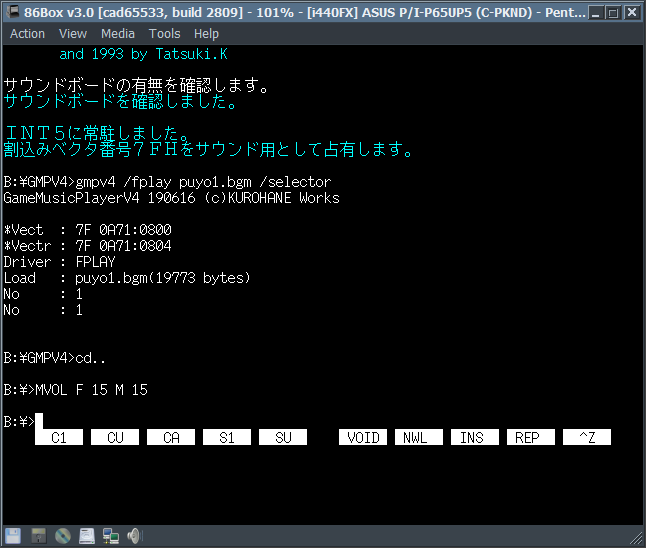
98/V running MS-DOS in 86Box
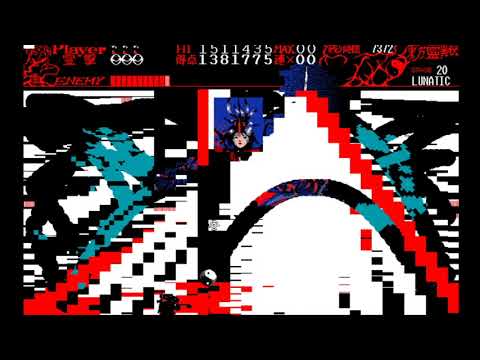
Graphical artifacts in Touhou Reiiden formed by the lack of EGC support (no blitter)
|
|
| Author: |
T.Okano |
| Status: |
Freeware / Abandoned |
| Release date: |
1997/11/27 |
| Last updated: |
1998/11/01 |
| Guest type: |
16/32-bit (286 and 386SX) |
| Minimum requirements: |
Windows 95/NT4, 32-bit host CPU, DirectX compatible graphics |
| Emulated video: |
PC-9801VM + 16-color / PC-386 equivalent |
| Emulated audio: |
Proprietary YM2608 (OPNA), PCM, Beeper |
| Passthrough: |
Host MIDI (MPU-401) |
| Rating: |
Not recommended! Use for historical purposes only |
| Download: |
pc98e.zip |
Another very old one, however this is the first known non-commercial PC-98 emulator.
There is not a lot of information available on it. What is known is that, due to use of a VxD driver, it will not run
on any modern operating system, so it's usefulness is extremely limited. It also requires a specific set of dumped firmware.
Even on supposedly supported operating systems, the emulator did not work for me, so I can only provide Emu-France's singular screenshot of it.
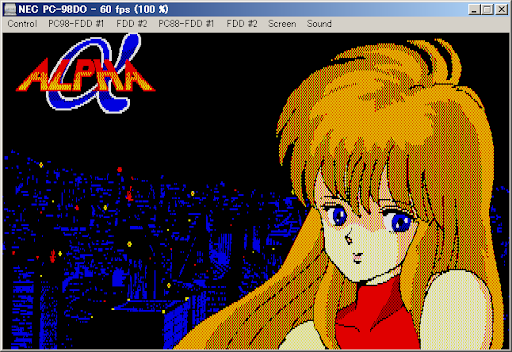
PC-98E in action, courtesy of emu-france.com
|
|
| Author: |
Soltin |
| Status: |
Freeware / Abandoned |
| Release date: |
1999/05/30 |
| Last updated: |
1999/12/14 |
| Guest type: |
32-bit (386) |
| Minimum requirements: |
Windows 95/NT4, Processor with MMX instructions, 256-color capable graphics |
| Emulated video: |
PC-9801VX equivalent |
| Emulated audio: |
Proprietary YM2608 (OPNA), Beeper |
| Passthrough: |
None |
| Rating: |
Obsolete |
| Download: |
virtual98.zip |
The first truly decent PC-9801 emulator. It's the first to provide Rhythm channel emulation on OPNA as well as a software EGC implementation,
finally providing blitter emulation without the need for a separate card. It does however need the required firmware to start, like BIOS.ROM and FONT.ROM,
as well as the Rhythm channel sample set, both of which would see use in future emulators.
It's three major drawbacks are the limited guest CPU speed options of only 5 or 8 MHz, the need for using it's proprietary disk formats,
and incomplete emulation of the text GDC.
The benefits of running this emulator are minimal as it's outperformed by Anex86, and both it and Neko Project II provide significantly more features.
Game compatibility is spotty. Touhou Huumaroku boots and plays fine, Puyo Puyo has problems drawing custom glyphs, and Madou Monogatari 1-2-3 cannot
start the dungeon crawling segments at all.

Text drawing anomalies are visible in Puyo Puyo
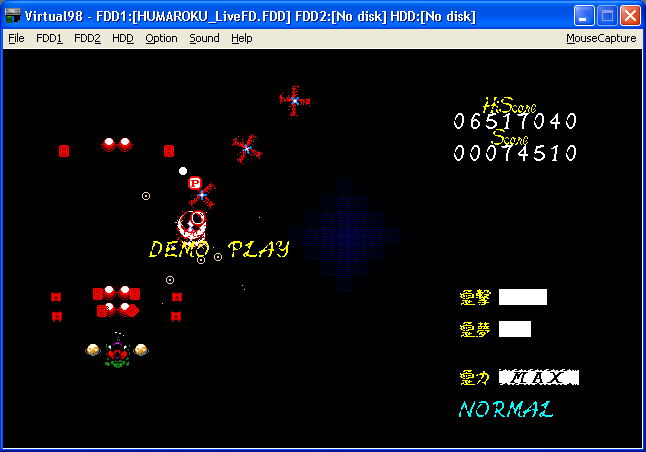
The Touhou Project games can blit objects properly
|
|
| Author: |
A.N. |
| Status: |
Freeware / Abandoned |
| Release date: |
Unknown |
| Last updated: |
2004/07/04 |
| Guest type: |
32-bit (486) |
| Minimum requirements: |
Windows 95/NT4, 256-color capable graphics, DirectX preferable |
| Emulated video: |
PC-9821 equivalent |
| Emulated audio: |
Proprietary YM2608 (OPNA) without Rhythm support, 86PCM, Beeper |
| Passthrough: |
CD-ROM, MIDI, RS-232C |
| Rating: |
Situationally useful |
| Download: |
anex86.zip |
Technically not a PC-9801 emulator, rather an Epson PC-486 emulator but functionally the same, Anex86 is the first popular PC-98 emulator, and for many good reasons.
For starters, it is very fast for it's time. It can provide a somewhat performant, even if a bit too eager to frameskip, experience in action games on a 500MHz Pentium II/III, and it will run
the guest as fast as it can drain resources from the host system's processor. It also provides a module/plugin system, with which support for CD-ROM and Serial passthrough are implemented.
It introduced the .FDI and .HDI disk image formats, which would become de-facto standards in the scene.
Software compatibility is surprisingly good for it's time, and the completeness of it's text GDC emulation is unmatched to this day.
The uncapped-by-default guest performance can potentially introduce speed related issues for games though, and the lack of Rhythm channel support detracts from the playback quality of it's YM2608 emulation.
Likewise the FM and SSG emulation isn't the most precise. Taking all of this into account, DOSBox-X and the Neko Project II family of emulators are usually better choices.
Consider using it if you're limited on host system performance or need accurate text GDC emulation.
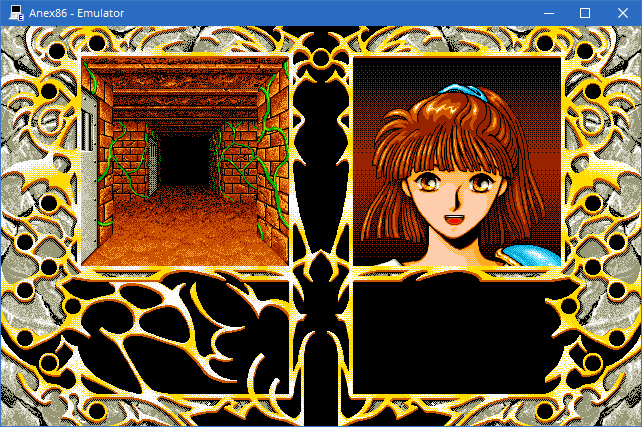
Anex86 successfully booting Madou Monogatari 1-2-3
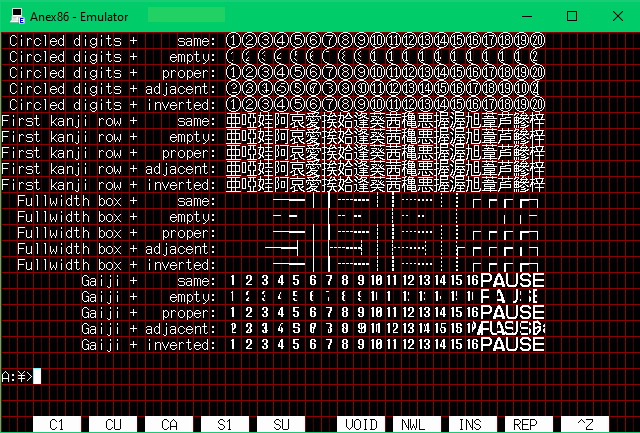
Anex86 emulates all glyph drawing modes accurately
|
|
| Author: |
YUKI, LED, Dirac |
| Status: |
Freeware / Abandoned |
| Release date: |
1999/03/25 |
| Last updated: |
2000/06/14 (T98), 2010/10/01 (T98-Next) |
| Guest type: |
16/32-bit (8086-80386) for T98, 32-bit (486SX/486DX) for T98-Next |
| Minimum requirements: |
Windows 95/NT4, DirectX 3.0 |
| Emulated video: |
PC-9801VM equivalent (T98), PC-9801VX equivalent (T98-Next) |
| Emulated audio: |
Proprietary YM2608 (OPNA), Beeper, 86PCM (T98-Next) |
| Passthrough: |
None (T98); MIDI, Printer, RS-232C (T98-Next) |
| Rating: |
Not recommended! |
| Download: |
t98.zip / t98next.zip |
Not every one can be a hit. T98 is another early emulator, but it's certainly not one that can displace it's competition.
Software compatibility is extremely low, it only runs in full-screen, disks cannot be swapped at runtime, and the only form
of configuration is directly editing a poorly documented .INI file. It is notable as the first PC-98 emulator to implement
save states though.
In only a year the project was rebooted as T98-Next, aiming to bump up the guest to a 486 class one, introducing an actual GUI,
adding support for external modules, and improving software compatibility. Unfortunately it still falls short in several areas.
A lot of operating systems aren't even able to boot (ex. FreeDOS98), VBlank timed programs run a bit too quickly, EGC emulation
is full of bugs, and outright incorrect program behavior can also happen.
Having only seen minor updates since 2003, there's way better options these days. Avoid if possible.
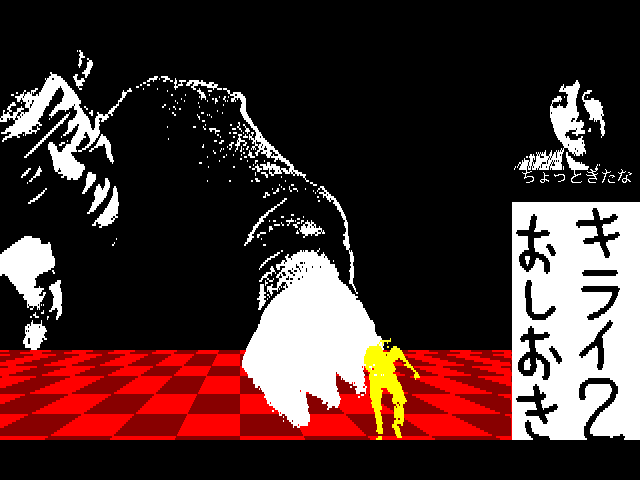
Oshioki Kirai 2 is one of the few games I have that can actually run on classic T98
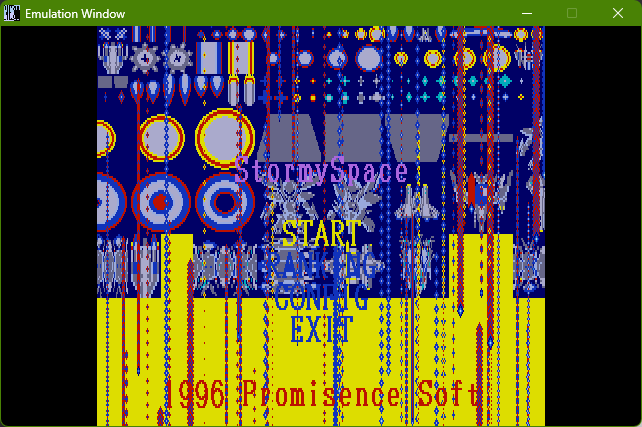
Completely broken EGC accelerated graphics drawing in Stormy Space under T98-Next. Courtesy of Nmlgc.
|
|
| Author: |
Yui, NP2 Development Team, RetroPC Foundation |
| Status: |
Free and Open Source (Modified BSD License) / Abandoned |
| Release date: |
1999 |
| Last updated: |
2016/03/06 |
| Guest type: |
16-bit (80286) for NP2, 32-bit (80386) for NP21 |
| Minimum requirements: |
Windows 95/NT4 + DirectX, MacOS 9, Windows CE Xscale |
| Emulated video: |
PC-9801VX equivalent (NP2), PC-9821 equivalent (NP21)
16/256 color support, GRCG and EGC presence are configurable |
| Emulated audio: |
Proprietary YM2608 (OPNA) + ADPCM, Beeper, 86PCM, WSS |
| Passthrough: |
MIDI, RS-232C |
| Rating: |
Obsolete |
| Download: |
Official homepage |
Neko Project II defines the start of modern PC-98 emulation, with an increased focus on accuracy and a wider range
of emulated hardware. The amount of options is significantly higher than any other emulator of the time. Base clock,
clock multiplier, machine class, selected sound board, memory availability, graphics acceleration presence, grayscale
LCD filtering, frameskipping, save states, etc.
Most notably it is the first open source PC-98 emulator. As such, several forks have spawned with an aim to improve aspects
where the original project fell behind: sound emulation (np2fmgen), Windows-era hardware support (np21/w), increased portability on
modern systems (np2kai), support for RISC Windows NT (np2_gdi), and others. The first two will be described in further detail later
on the page.
Instead of providing 16-bit and 32-bit CPU emulation in one package, the emulator can either be built as Neko Project II,
providing 16 color support and 286 emulation, or Neko Project 21, providing 256 color support and 386 emulation.
Project development had stopped in 2016, so it's forks have largely rendered it obsolete.
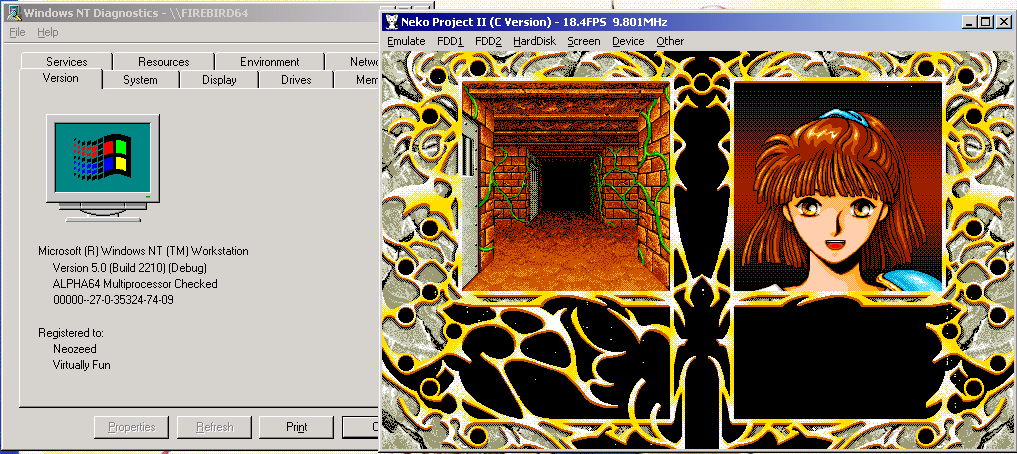
A build of Neko Project II GDI for the 64-bit Alpha AXP version of Windows NT, running Madou Monogatari 1-2-3

Neko Project 21 displaying a 256 color image
|
|
| Author: |
Nenecchi |
| Status: |
Freeware / Active |
| Release date: |
2012/03/03 |
| Last updated: |
2024/10/03 |
| Guest type: |
16-bit (80286) for NP2, 32-bit (80386) for NP2SX and NP21 |
| Minimum requirements: |
Windows 95/NT4 + DirectX |
| Emulated video: |
PC-9801VX equivalent (NP2), PC-9821 equivalent (NP2SX/NP21)
16/256 color support, GRCG and EGC presence are configurable |
| Emulated audio: |
YM2608 (OPNA) emulation through fmgen.dll, ADPCM, Beeper, 86PCM, WSS
Alternatives external FM cores can be selected |
| Passthrough: |
MIDI, RS-232C |
| Rating: |
Recommended |
| Download: |
Official homepage |
Starting off as a fork of Neko Project II 0.83 with the FM core replaced with FMGEN, np2fmgen has become the most
highly used fork in the np2 family. It's emulation of the OPN/OPNA is of a significantly higher quality than any previous
implementation, and unlike the original np2 it is still maintained and receives bugfixes. Some fixes are taken from other
forks, others aren't. Additionally, it supports loading other external FM cores, so if you want to use MAME's core, or
even hook into a real chip with the G.I.M.I.C, it's a possibility.
The biggest downside unfortunately is that this fork is not open source, so it is not possible to examine it's code or
make ports to other platforms.
|
|
| Author: |
simk98l |
| Status: |
Free and Open Source (GPL, MIT, modified BSD) / Active |
| Release date: |
2016 |
| Last updated: |
2024/05/19 |
| Guest type: |
16-bit (80286) for np2w, 32-bit (various, up to Pentium 4) for np21w, 32-bit virtualized for np21w HAXM |
| Minimum requirements: |
Windows XP (32-bit), Windows Vista (64-bit, HAXM) |
| Emulated video: |
PC-9821 equivalent + various SVGA boards for use in Windows
|
| Emulated audio: |
YM2608 (OPNA) emulation through fmgen, ADPCM, Beeper, 86PCM, WSS, SoundBlaster 16 DSP + YMF262 (OPL3) |
| Passthrough: |
MIDI, RS-232C, Named Pipes |
| Rating: |
Recommended |
| Download: |
Official homepage |
The second most popular fork of np2, SimK's np21/w aims to add more features and improve support for Windows 9x and NT/2000 emulation,
although due to the improvements it brings it is also popular amongst those who only play DOS and self-booter games. It also comes with
fmgen, so sound emulation is on par with np2fmgen.
The most notable additions are improved IDE emulation, support for named pipe hooked COM ports , and many added sound and video boards,
some of which are even supported by DOS games. For users of Windows NT and 2000, A separate build uses Intel HAXM for hardware assisted virtualization
of 32-bit code, greatly improving performance and host CPU instruction support.
It is still actively developed, and unlike np2fmgen it is fully open source.

Neko Project 21/w connecting to the internet with PPP through a named pipe.
|
|
|


